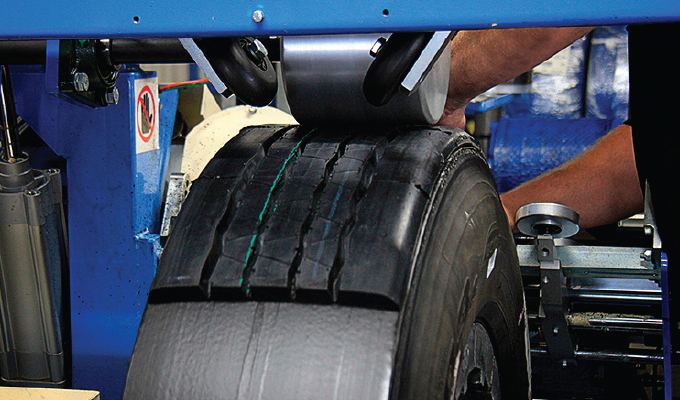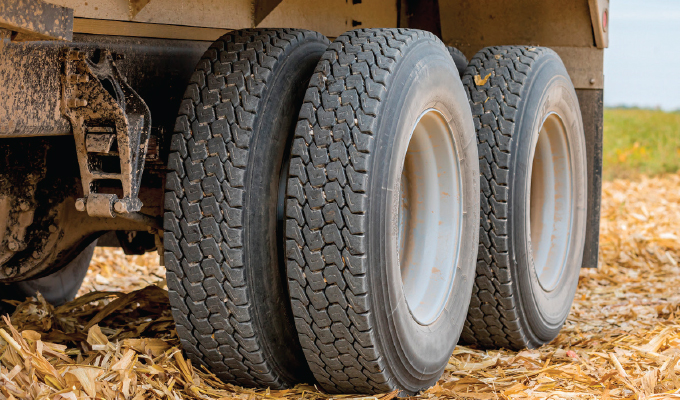By Callie Vanek
The COVID-19 pandemic has most companies searching for savings and operating efficiencies. When it comes to a work truck fleet, leadership may be able to find those opportunities where the rubber meets the road. Retreads are a sustainable way for fleets to optimize productivity while cutting down on cost per mile. Whether you’ve considered retreads before, they are definitely worth looking into. To help with your evaluation, we’re debunking some of the most common retread myths.
MYTH #1
“Retreads are unsafe.” One of the most tired retread myths we hear today is that they aren’t safe. But in fact, the safety of tires, whether new or retread, often comes down to care of their casings.
One of the most common causes of truck tire failures is underinflation. Underinflated tires experience excessive sidewall flexing, which causes them to run extremely hot. This buildup of heat can lead to tread and casing separation and unexpected blowouts. Needless to say, the safety of your tires largely depends on the tire maintenance practices your fleet follows.
The overall quality of retreads has increased dramatically over the years, and retreading is held to the same standards of quality as new tires in terms of tread depth and other safety concerns. Today, retreading is a controlled process using advanced technology, equipment, and comprehensive inspection techniques.
The TA Commercial Tire Network Retread Center, for example, uses nondestructive testing techniques at initial inspection and a high pressure inflation tester in the final stages of retreading, as well as the latest cutting edge Shearography equipment to ensure only quality casings are retreaded.
The truth is that new tires today are crafted to be retreaded, and only casings that pass a rigorous safety test are selected for the retreading process. Work with a quality manufacturer and take care of your casings, and you can expect the same level of safety as new rubber from your retreads.
MYTH #2
Retreads don’t perform as well as new tires.” The lower price tag of retreads might make it feel like you’re sacrificing performance, but many of the quality retreads available have proven to perform comparable to new tires. Plus, dependable tire performance is closely tied to choosing the right retreads for your fleet’s application and establishing a tire maintenance routine.
You want to shop for retreads the same way you’d select a set of new tires. In order to achieve optimum performance, you must make sure you’re purchasing the right retreads for your application. Determining the position in which your retreads will be placed and what application they will be used in should be the first steps you take when purchasing tires.
You also might be surprised to find out that more than 80% of all aircraft tires in use in the US today are retreads. From fighter jets to school buses, retreads move some of our most important cargo across many industries. If retreads didn’t perform, would they be used every day by ambulances, fire engines, air crafts, and more?
Work with a trusted tire partner and service provider to ensure you’re getting expert tire advice and quality retreads, like Goodyear and Bandag models, which are offered nationwide through the TA Truck Service Commercial Tire Network.

Myth #3
Retreads aren’t good for harsh applications.” This again comes down to proper maintenance and running the right tires and tread compound for your application and operating environment. You wouldn’t choose a traditional low rolling resistance retread, for example, if you’re operating in a rugged off-road application. You may instead look for retreads with higher traction and improved cut resistant compounds, which are widely available in the market.
Sometimes there is worry when it comes to wear, but just because the tread is worn on a tire, doesn’t mean the casing is unusable. Quality casings can far outlive their original tread, and if you’re taking care of your casings, your fleet may opt to retread your own application-specific tires that you already know are a fit for your environment.
Knowing the load and inflation history of your fleet’s tires can also be helpful in determining which of your casings are better suited for certain wheel positions. Work with a quality retreader and service provider who can create a tailored cradle to grave tire management program to ensure you’re maximizing your original tire investment.
Myth #4
Retreads will only end up costing you more.” Did you know that retreading actually saves the trucking industry over $3 billion each year? The most expensive part of a tire is its casing. Since retreads are made using existing casings, they cost much less to produce than new tires. Manufacturers pass that savings to their customers by selling retreads for less than the price of a similar new tire, and in fact, retreads can cost as much as 30 to 50% less than new tires.
Since the performance of today’s quality retreads is comparable to new tires, retreading is the most effective way to lower your total tire costs and increase the competitiveness of your business. With proper care and the right tire management program, retreads will indeed save you money both up front and in the long run.
Myth #5
Retreads wear faster and cause more blowouts than normal tires.” Retreads have a reputation for causing that rubber debris often found on the side of the highway. However, studies show that 68% of tire debris collected on the highway actually comes from new tires, not retreads.
The reality is that retreads will wear at the same rate as new tires if you aren’t properly maintaining them. We know that tire failures, whether new or retread, are mostly related to improper inflation, among other culprits like worn parts, misalignment, overloading, and more.
The easiest way to avoid tire-related downtime is to implement a thorough tire management program that includes regular inspections and maintenance of all wheels and tires. Retreads are still a major investment and require engaged maintenance practices, such as daily tire checks, to ensure pressure levels are adequate and match the load hauled.
Thanks to time and technology, modern retreads are made with a much higher level of quality than they were decades ago. Next time you need to make a tire purchase, talk to a TA Truck Service tire expert about which retreads might be a fit for your application.
ABOUT THE AUTHOR
Callie Vanek is the director of the TA Truck Service Commercial Tire Network. Find out more, visit www.ta-petro.com.




